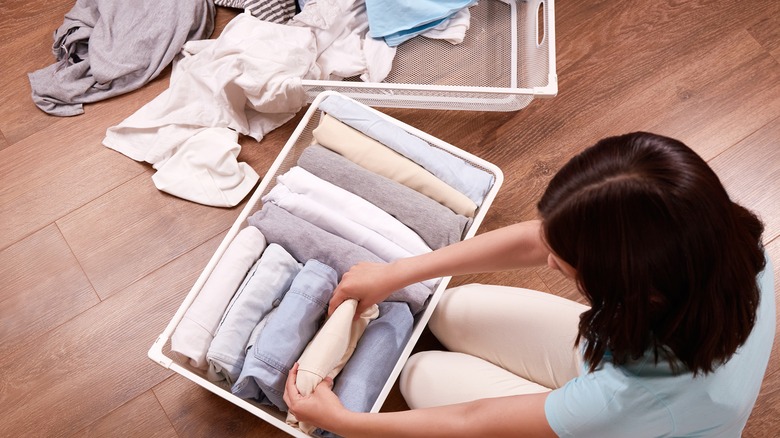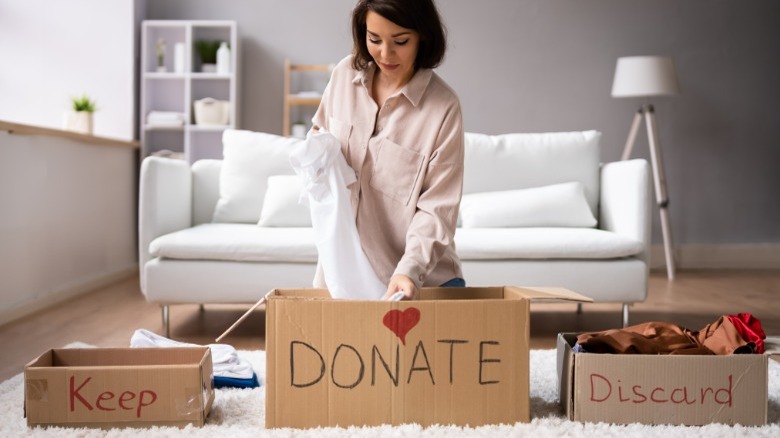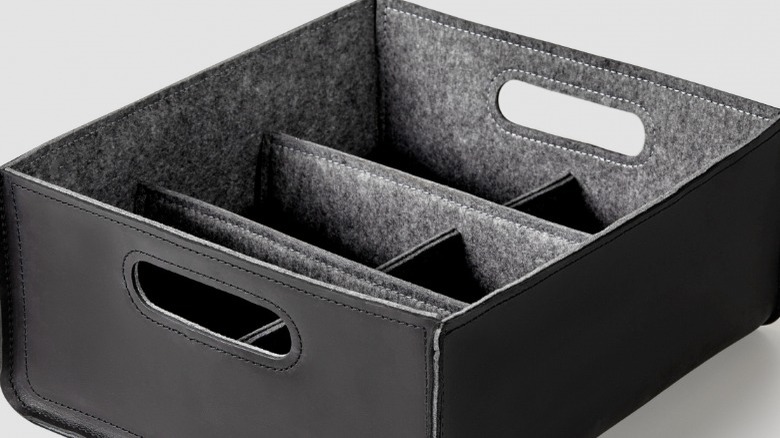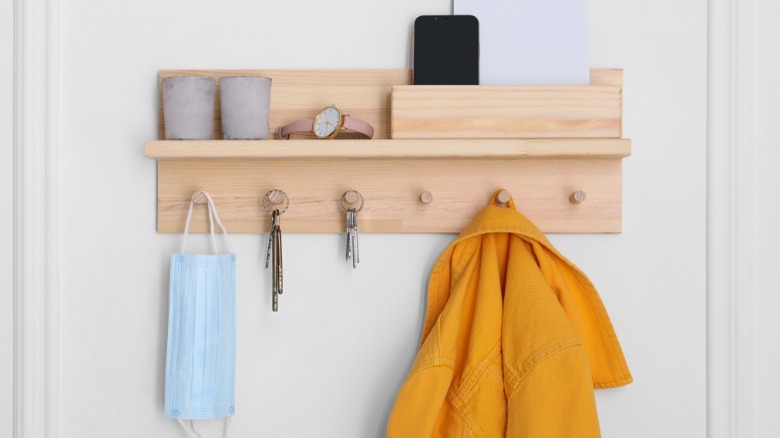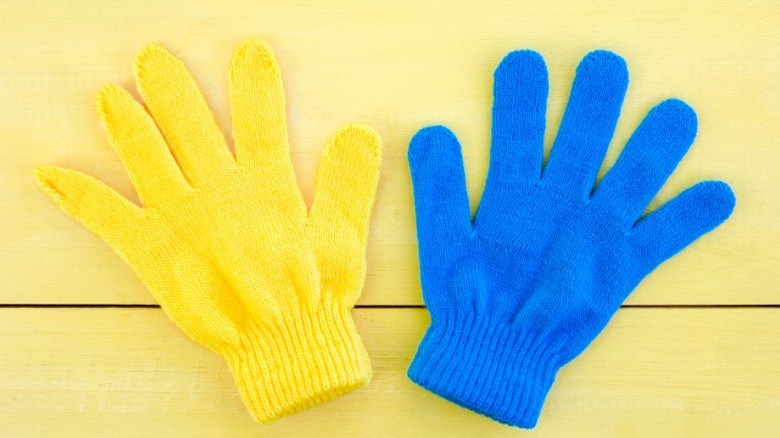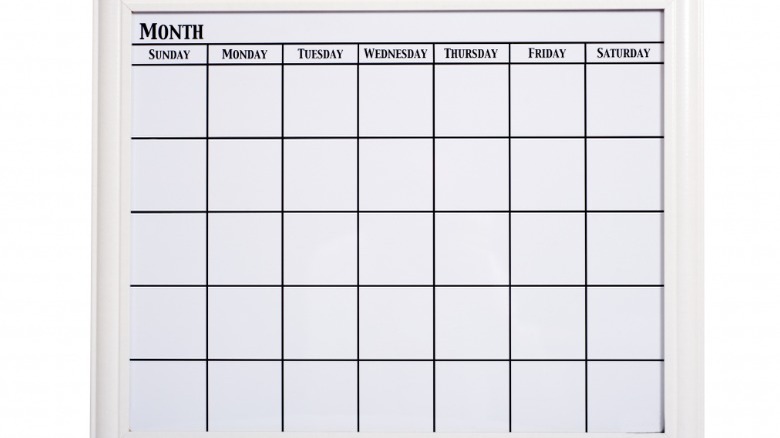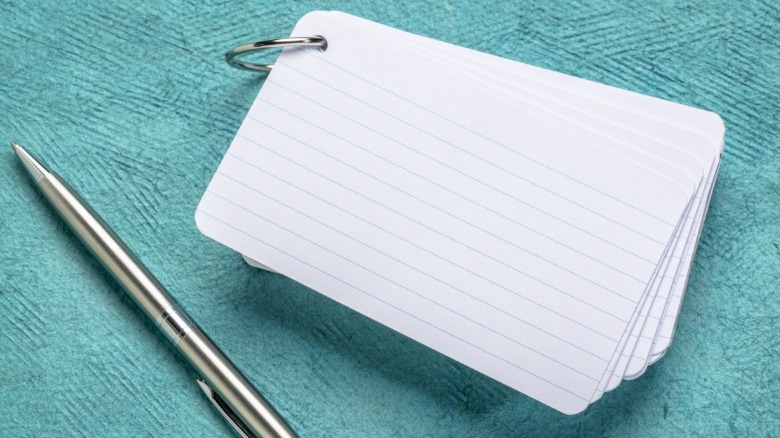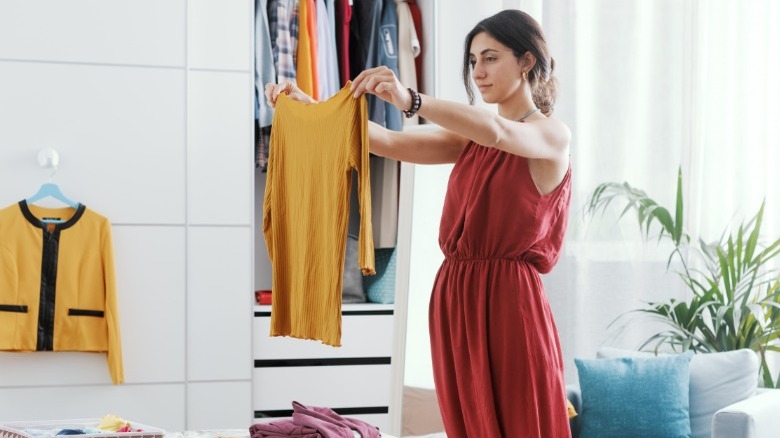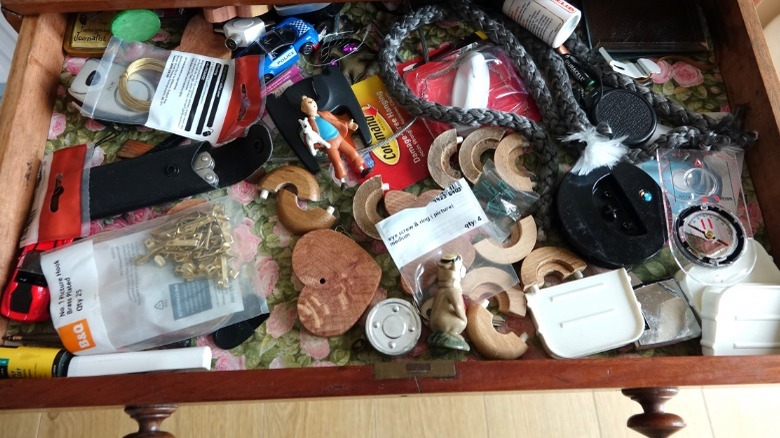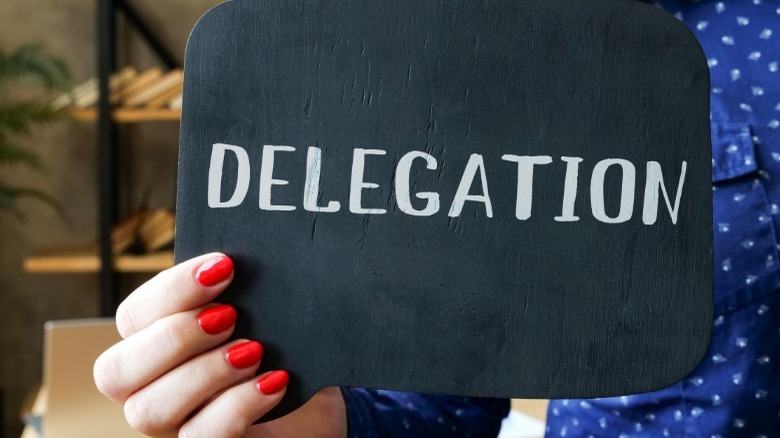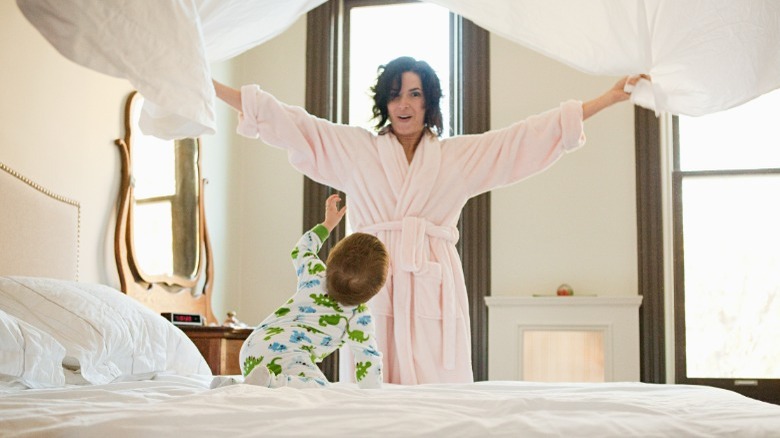How To Get Your Home Organized When You Have ADHD
Staying organized can be challenging for people with ADHD because the symptoms include difficulty focusing on tasks, impulsiveness, and excessive, misdirected energy. The key to keeping your life running smoothly is to start at the heart of the matter — your home. Staying organized is difficult with ADHD, and sitting down and putting a room back in order isn't a linear task. You often get distracted with other chores, and what might take one person five minutes to clean will take a neuro-divergent person an hour to tidy. That's why you need systems in place to help you curb the clutter in the first place.
There is a real sense of satisfaction and empowerment when you see how well these systems work. From having Doom Boxes to contain clutter to initiating task timing to help with time blindness, there is something for everyone. But you don't have to tackle all of these at once. Experiment with one at a time, and choose the organization tips that best meet your needs.
Try the four-pile system
ADHD makes it hard to focus on tasks, and having too many stimuli in a room makes it even more challenging. There might be a bunch of unopened mail on one table, pet toys all over the floor, and too many tchotchkes on your tabletops. While neuro-typical people can walk into a messy room and begin organizing, people with ADHD need an easy system to help keep them on task. That's where the four-pile system comes in, especially if you need to do something as difficult as decluttering and pruning your belongings.
Starting with one room, gather all of the stuff into a large basket or pile. Split this into four smaller ones as follows: throw away/recycle, donate, storage bin, and keep. This will take time; if it's too difficult, ask someone to help. Sometimes, an objective opinion about that scarf you bought in 1980 will help you decide. Once one room is completed, take a break before moving to the next one. Then, you can throw out or recycle everything at once, gather the donation-worthy things and drop them off, and store away what can be stored.
Avoid re-cluttering
After all that hard work, you don't want to re-clutter your house by power shopping. This will create a frustrating cycle that will require you to constantly prune items and make difficult organizing decisions. Since that isn't easy for you, break the habit by setting a reasonable monthly shopping budget for personal items and stick to it as best you can. You can transfer excess money out of the checking account after bills are paid, and deposit it into an interest-bearing account or invest it. This can be set up automatically online to make it easier.
If not buying things brings you down, there are other ways to treat yourself. Instead of buying an extra, unnecessary set of dishes, use the money for rewarding adventures. A weekend beach trip with friends or a cooking class can be even more enjoyable than shopping, with longer-term benefits. Your time is valuable; you can use it to strengthen bonds with loved ones and experience the world.
Design a Doom Box in each room to capture clutter
Doom Boxes have been trending on TikTok, but the name can be misleading. They don't represent the end of the world. Instead, "doom" stands for "Didn't Organize, Only Moved." This is a decluttering strategy that can really work in ADHD homes, and you can assign one to each room. The theory behind Doom Boxes is straightforward, and here's a before-and-after example. Each morning at your work desk, you take out your notes, phone charger, a box of tissues, binder clips, and other items you use. These are in separate drawers, cubby holes, and containers. At the end of your workday, each item is returned to its designated spot.
Who has time for that?
A Doom Box eliminates all that extra back and forth. Get the right-sized container and stash all that stuff inside — if you find one that has sections, that's even better. This way, your space will look neat and ready to go the next day. You won't be distracted by too many stimuli and will quickly locate the things needed to get on with your day because they're all in one place.
It's also great for corraling general clutter in the room. Say you're in the living room and notice things are out of place. Rather than forcing yourself to put them away, which can be difficult, you can pop them into the box to sort later. You can put everything from your pajama bottoms to a drinking glass to the crafting materials you brought out a few days ago, containing the mess into one designated space.
Experiment with task timing
Tasks like decluttering a room, reading through dozens of emails, and paying bills can be time-consuming, so it's easy to lose focus and be unable to finish. Task timing can help you break these chores down into manageable chunks of time.
Suppose you haven't cleaned your garage out for a year, and the thought of cleaning up the dried leaves, piles of old newspapers, and old bike parts is too overwhelming. Avoid thinking about the big picture, which can give you choice paralysis. Instead, break up the chore into a series of small tasks that can be accomplished in small blocks of time. Put on some old clothes and set a timer for 15 minutes. Start working and as soon as the timer goes off, stop what you're doing and take a break. Congratulate yourself for what's been finished, take a break, and set the alarm for another 15-minute run. If you can't concentrate on the task for that long, shorten the time; you might be able to increase it gradually. And if you prefer not to time yourself, break it down into one task at a time. Tell yourself you'll tidy the garage shoe cabinet today and nothing more. It might take longer to clean this way, but the task will still get accomplished.
Have a place for everything
If Doom Boxes aren't your thing, organize your home by designating certain areas by activity. One idea is to hang a key and coat holder by your front door. And since people with ADHD have trouble remembering things they can't immediately see, clear bins can solve this problem. Otherwise, feel free to label the lids. That is a great way to organize things like your daughter's softball uniform and gloves, all your pets' items, or your electronics.
If acrylic boxes aren't your thing, labeled baskets can also serve this purpose, and you can find ones that match your decor. Just use a label maker to write what's inside each one. No matter the style of the container, ensure you place them strategically around the house. Leave a small one on the table near your front door and use it as a drop spot for keys and your pet's leash. In the laundry room, have one basket for dirty clothes and a second for folded ones. Just try not to have too many baskets or bins in one area because things will get cluttered. You can also designate drawers in the same way. Having a place for everything means you won't be rushing around trying to find things when you are already running late.
Make a lost-and-found basket
Looking for missing socks, gloves, keys, sunglasses, and countless other items is incredibly frustrating, and most of the time, these things turn up in unexpected places. A smart way to keep track of them is to make your own lost-and-found basket. Schools and businesses rely on these systems, and you can, too. Place it in your entryway or another spot where everyone in the house will often see it. When you find something lost, immediately put it in the basket and go about your business.
Set a weekly reminder to go through the basket and empty everything out. Return everything to its partner, location, or owner, and breathe a sigh of relief. Rest assured that it will be filled up again soon, and you can quickly match things up again. Encourage other family members to do the same. This works especially well when someone else finds your missing earring, but you're not home for them to give it to you.
Keep medications in order
This is an important one because skipping medication doses and losing bottles can lead to serious health consequences. The best way to organize them is with a pill planner. These are sold in weekly, bi-weekly, and monthly versions. If you have a regular monthly prescription, the third option is the best because you only need to refill it with pills once every 30 days. You'll see when they are close to running out and can prepare accordingly. If you are prescribed something like steroids that are shorter-term, one of the smaller pill planners might work better.
If the pill planner fits in your medicine cabinet, keep it in there; otherwise, a bathroom drawer is the next best spot. Do not move it out of the bathroom. People with ADHD forget where things are stored, so keep them in one location. For renewable prescriptions, set up reminders through your pharmacy. This is usually done online, and you'll need to create an account with a username and password. Then, the system can text or email you when it's time to renew and alert you when the medication can be picked up. Set the reminder times for one week before prescriptions expire, and renew them right away online or by phone. The pharmacy will message you if the renewals are expired and the doctor's office needs to be contacted.
Create a family calendar
Remember the last time you missed your son's soccer championship or were late for an important doctor's appointment? The chances of this happening decrease significantly when you have large visual reminders like family calendars. Digital ones can be helpful, but the events can be forgotten if you aren't consulting them often. People with ADHD find it challenging to remember dates and events, and when there are many of them, it all becomes confusing. A family calendar will clearly show everyone's activities a month at a time.
Having a hard calendar in a high-traffic area like your kitchen refrigerator makes good sense. Everyone will see this several times a day, and you can X-out days after they pass. A dry-erase board with different-colored markers is a good choice because it can be used over and over again. Plus, when appointments and events change — and they often do –they can be erased and rewritten. If you forget to look at it, set a reminder to check it each day at a certain time, early in the morning. And try to look at the whole month instead of the current day, so you'll know what's coming down the road.
Switch to index cards
The problem with to-do lists is their tendency to get too long to make any headway with them. However, they can still be useful tools if you make them ADHD-friendly. Instead of using 8-½" x 11" sheets of paper, switch to index cards. These have room for fewer tasks, and you can limit those to just one to three per day. The cards can be attached to your refrigerator or another centralized location where they will be seen often. You can also keep them by your laptop. Cross out each task when completed, and don't add any new ones.
Those other tasks nagging at you need to be remembered, though, so what should you do? Write three more on the next index card, which you can do the following day. Keep your cards in a designated area and refer to them often. You'll find that a list of three things is much more manageable than a larger one. And remember, in most cases, what you can't do today can be done tomorrow. Or next Thursday, even.
Organize your wardrobe closet
Closets can be significant pain points for people with ADHD. They contain a lot of pieces that need to be folded, hung up, organized, and stored, which can become overwhelming. The best thing you can do is have a streamlined capsule wardrobe that doesn't require dealing with an avalanche of clothing. But if that's not your style, the next best thing you can do is create forgiving organizing systems.
What do we mean by "forgiving"? Rather than forcing yourself to fold and organize everything Marie Kondo style, take an easier approach. If you hate folding, create systems where you can throw freshly laundered clothes into baskets, bins, or drawers. Cotton and linens are more prone to wrinkling, so stick with synthetics like polyester and fabrics like wool. If you know a drawer is designated for your workout shirts, toss them into the drawer without folding them. The same goes for the drawer of sweatpants underneath and the sweatshirts underneath that one. Put clear bins on your open shelves, and do the same with sweaters and synthetic shirts. That means you're left hanging just a couple of pieces, which is much more manageable than folding and putting away everything else.
Eliminate junk drawers
Kitchens, craft rooms, and workshops are hotspots for junk mail, spare parts, and other things that you don't want to toss out right away. After all, there might be an amazing coupon or a few extra screws that you might want later on. It can be hard for people with ADHD to throw things out, but these small things clutter up kitchens and make it hard to find the things you do need.
Clearing out the junk drawer can be intimidating because it gathers the house's random odds and ends. That means there are a hundred opportunities to get distracted and go on a side quest. To tackle this feat, do two things: First, schedule the decluttering task on your phone. If an alert goes off once a week to tackle the chore, you'll be much more likely to do it. Second, time box the chore, which means you stop the task the second the timer goes off. This makes doing something you don't like less intimidating, since you have permission to stop once the allotted time is finished. You'll likely get distracted and won't finish clearing the entire drawer, but you can pick it up again the week after.
Be willing to delegate
Being responsible for an entire household is more than just removing clutter and tidying rooms. The chores can seem endless, and just when you have finally finished vacuuming, you remember that the bills need to be paid, the dog needs to be walked, and the groceries ordered. It isn't always easy to delegate responsibilities to other family members because the control also gets transferred to them.
Delegating tasks is more than telling your partner that the laundry basket is overflowing. Make a list or diagram for the job you need to be delegated. Write down the new owner's name and how the task must be completed. Here's an example. For laundry, write something like, "sort laundry, put in the washing machine, put in dryer, fold, put away in drawers." Estimate the time needed for the task to be completed, too. Then, give the diagram to the new owner; if they have feedback, add it. Once a few tasks are delegated this way, less will be on your plate to juggle.
Paying bills on time and repairing broken dishwashers can be different, though. If you cannot teach household members to do these things, they can still be delegated. You can set up automatic bill paying through your bank or other financial institutions through your online accounts, and hire professionals to complete your repairs. Use Post-it notes to remind yourself to do these things, or write them on the family calendar.
Start every day by making your bed
Even though you spend most of the time in your bedroom sleeping, clutter in this room can create feelings of anxiety. A decently-made bed can give you a sense of control and give you momentum to accomplish the other tasks you have that day. Making a bed is a fast, manageable habit that can set the tone for the rest of the day, but this should be done right when you get up because you will likely become distracted and not remember. Think of your alarm as a prompt to make your bed; an alternative one might be your feet hitting the floor. Make your bed instead of hitting the snooze button or picking up your phone — it can become part of your morning routine as long as it's done before you walk away from it.
And to make this simple task even easier, don't decorate your bed with many throw pillows and extra blankets. Keep it basic, and it'll only take a minute or two to put it together in the morning. Getting into a bed that's made is so much nicer than getting into a messy one. You deserve it, and it'll make you feel better about yourself.
